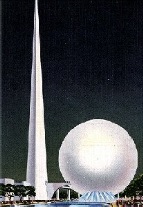|
1 |
 Copyright: |
|
1 |
 Copyright: |
From everywhere the landmark of the World fair, called Trylon and Perisphere, in the centre of the exhibition site was visible: it consisted of a triangular pylon 212 metres high and a sphere with a diameter of 65 metres in which the Theme Center was situated. The New York times christened the buildings “The Egg and the Tack” but the architect Wallace K. Harrison got actually inspired by a hair pin and a putty pellet. Together with his partner Jacques Andre Fouilhoux he created the most popular landmark of a world exposition since the Eiffel Tower. The purely geometrical abstract form and the glowing white exterior associated giant sculptures rather than exhibition buildings. The architects had numerous wood beams rammed into the marshy soil as foundations that bore the weight of the 10,000 tons steel structure. When the construction work was finished the picture had changed dramatically: the obelisk rose boldly into the sky and the sphere seemed to float in the air carried by water fountains. The longest escalator in the world transported the visitors to a ramp 20 metres above ground leading to the entrance. Inside, visitors stepped on two rotating balconies on two different levels seemingly suspended under the blue lit dome. One complete rotation took six minutes – exactly as long as the film, light and music performance that was repeated 120 times a day. From this elevated position visitors looked down on the visionary model of Democracity, a city in the year 2039.
In this city, houses, factories, administration and transport were placed in a way that kept distances short and reduced damage to the environment. A power plant on the river produced electricity for the whole city. During one rotation the visitor experienced a whole day in time-lapse. It got slowly dark under the dome, lights and stars in the sky appeared. Ten films projected a rousing vision on the dome supported by pathetic music. The voice of the popular radio presenter H. V. Kaltenborn announced the labourers of the ideal city who advanced in ten columns, formed a circle, blended and then dissolved into a symphony of colours. This overwhelming piece of propaganda was to convince visitors of the unlimited beneficial possibilities and the democratising power of technological and industrial progress.
A very similar concept had the exhibition in the General Motors pavilion – the Futurama also presented an ideal future. Up to 27,500 visitors a day glided over a detailed animated miniature world in movable seats: sweeping landscapes, industrial areas and a city with a sophisticated transport system utilising remote control cars – mentioned favourably again and again in reports at the time. The highlight of the show though was the fact that visitors had to feel transplanted into the future at the end because the last picture of the tour showed exactly the junction people exited to after the show.
Elegance, wealth and mobility as consequence of industrial and technological progress, impressive skyscrapers, complex transportation systems and powerful lighting systems also characterized city visions of other exhibitors. But not only visions of the future were presented. To celebrate the achievements of the electrical industry, Consolidated Edison showed a replica of Manhattan’s skyline simulating with a complicated lighting system all light conditions of a day – from dawn to gleaming bright sun light to the stars in the sky at night.
| Year: 1939 | City: New York | Country: USA |
| Duration: 30th April - 31st October 1939 und 11th | ||